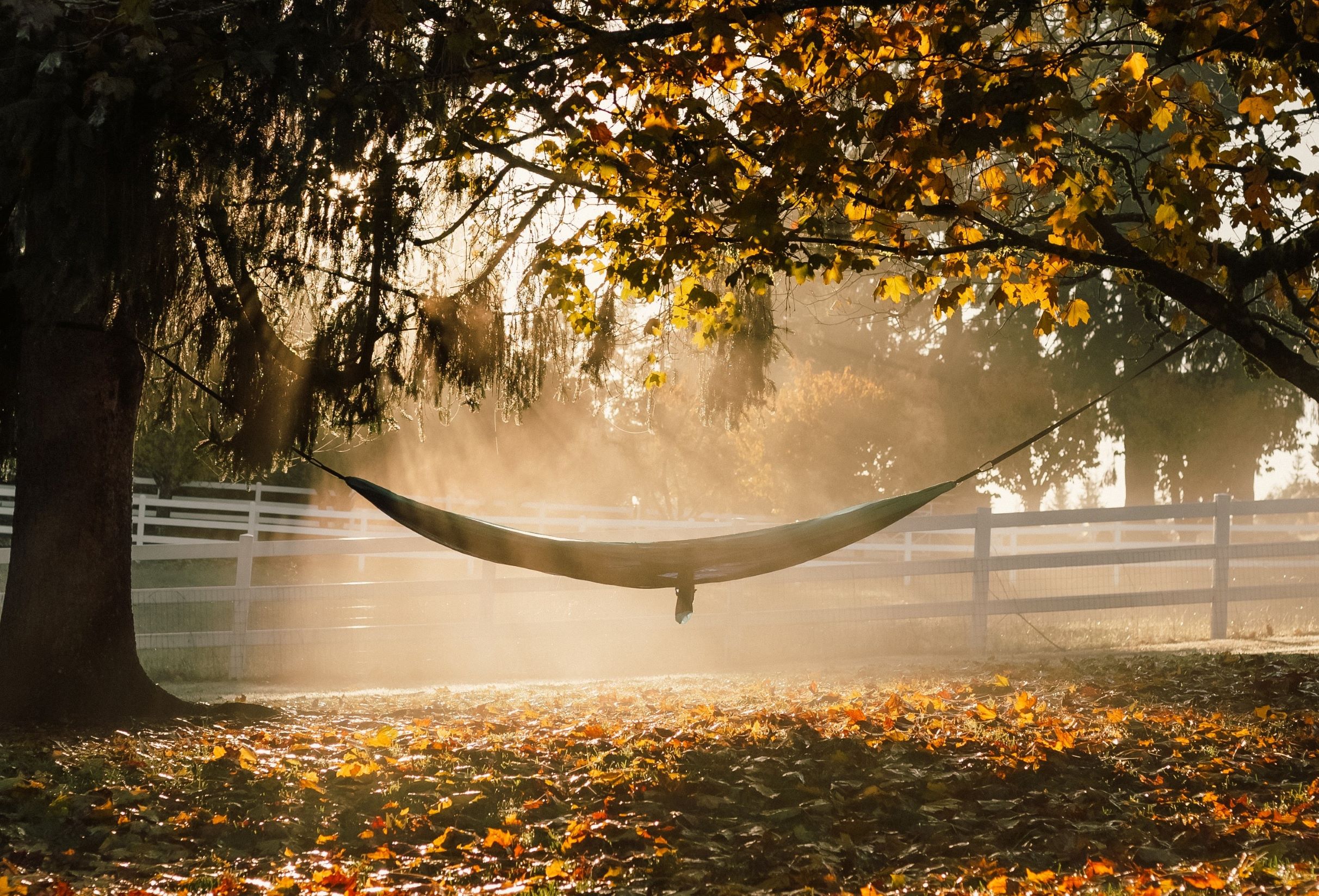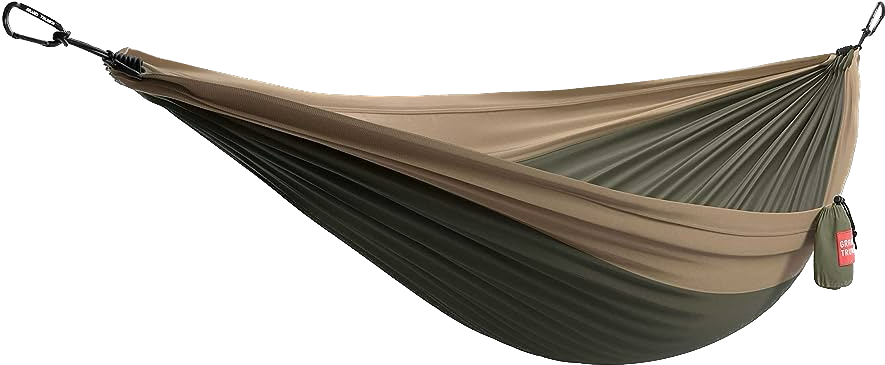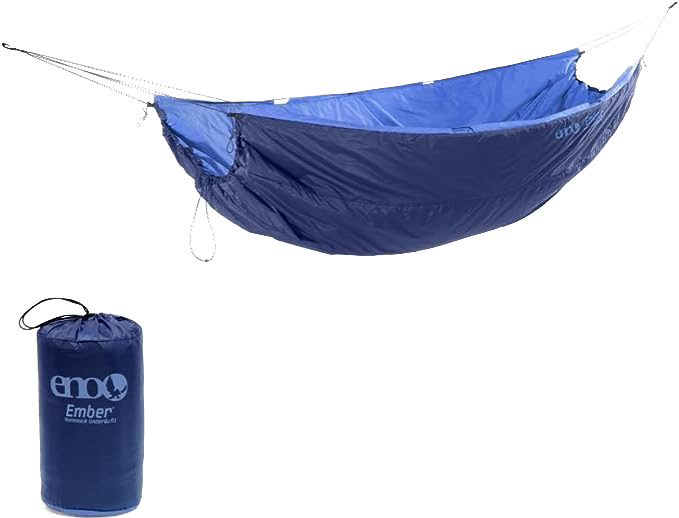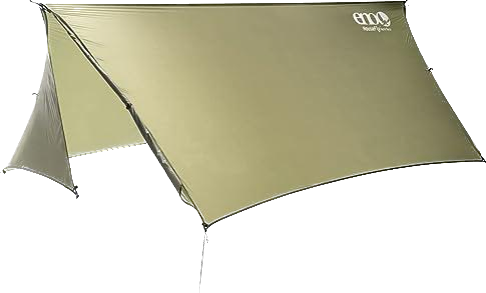We commonly hang our hammocks outside at home, on our lawns and patios, and in the great outdoors when camping. We often feel tempted to leave the hammock setup outside rather than continually taking it down and putting it back up again. But can you leave your hammock outside without shortening its life? Are there any risks or consequences associated with doing so?
Most hammocks are designed for temporary outdoor use and are not meant to be left outside permanently. Hammocks can degrade quickly when exposed to weather elements for long periods. Although weather-resistant and waterproof options can withstand being outdoors full-time, it’s important to remember that no hammock is indestructible.
Let’s take a closer look at some of the potential risks of leaving your hammock outdoors and what you can do to protect your investment.
Can Hammocks Be Left Outside?

There is no easy answer to this question since it can depend on a number of factors, such as the type of hammock, the climate, and how well the hammock is protected from the elements.
Naturally, most hammocks are not meant to be left outside permanently, as they can start to degrade when exposed to weather elements such as sun, wind, and rain. However, there are some hammocks on the market that are specifically designed for outdoor use and can withstand more exposure to the elements.
The most popular hammock fabrics are parachute nylon, cotton, polyester, and canvas. Of these, only canvas is truly durable enough to be left outside permanently without suffering significant deterioration. Polypropylene or parachute silk is also a common hammock fabric that is significantly weather resistant and can be left outside without taking a beating.
But irrespective of the type of hammock, it is always a good idea to take it down and bring it inside when you are not using it to prolong its life. All fabric fibers will start to break down eventually when exposed to the elements, and UV rays from the sun can accelerate this process. Also, continued wind exposure can damage the fabric and cause it to tear, while rain can lead to mold and mildew growth.
If you choose to leave your hammock outside, it’s important to take measures to protect it from the elements. For example, you might want to invest in a cover for your hammock or keep it stored in a sheltered area when it’s not in use. Additionally, you’ll need to inspect your hammock regularly for signs of wear and tear and replace it as needed.
A tarp or rainfly can also provide valuable protection for your hammock and help it last longer. By suspending the tarp over the hammock, you’ll create a barrier that will shield the hammock from direct exposure to sun, wind, and rain.
Can Hammock Straps Be Left Outside?
Here’s where things can get a little trickier. While most hammocks are made from weather-resistant materials, the same may not be true for the straps. Hammock straps are often made from polyester or nylon, which can degrade quickly when exposed to the elements.
Additionally, the loops or hooks on the ends of the straps can start to rust when left outdoors, making it difficult to attach them to your hammock stand or trees.
If you must leave your hammock outside for long, consider using ropes and carabiners with good moisture protection. This will help prolong your straps’ life and make them easier to use.
Can Hammock Stands Be Left Outside?
Again, this can depend on the material from which the hammock stand is made. Hammock stands made from steel or aluminum are more resistant to weather damage and can usually be left outside without significant issues. It is, however, advisable to coat them with a rust protector or WD40 and bring them in over winter to avoid corrosion.
However, wooden hammock stands will not fare as well when exposed to the elements and are best kept indoors or in a sheltered area when not in use. If you choose to leave your wooden hammock stand outside, apply a fresh coat of sealant such as Ronseal or varnish every season to help protect it from the elements. Also, clean them regularly with hot soapy water to keep the fungus and mold at bay
Can Hammocks Be Left Out In The Rain?
Hammocks can be left out in the rain, but there are some risks involved. The hammock’s fabric can mildew if it gets wet, and the metal parts can rust. Also, if the hammock is left out in the rain for too long, it can start to smell.
If you must leave your hammock out in the rain, consider getting one made of waterproof materials, and make sure to dry it off as soon as possible. You can also protect your hammock by using a tarp or rainfly that is properly secured to avoid getting blown off by the wind.
What Are Some Of The Risks Of Leaving A Hammock Outside?
Hammocks can have several accessories, including ropes, stands, bug nets, under quilts, chain links, hooks, and rainfly. Each of these items has the potential to be damaged by exposure to the elements. Ropes can fray, stands can rust, and rainfly can tear. In addition, the fabric of the hammock itself can fade or mildew.
Chain links and hooks can also become rusty and brittle, which can cause them to break. This is a safety hazard, as broken hooks or chains can collapse the hammock. You don’t want that to happen while someone is sleeping in it!
Another risk of leaving a hammock outside is that it can attract animals. Small animals and birds may nest in the hammock and become a nuisance, making it difficult to lounge in the hammock.
If rained on, the hammock can become waterlogged and heavy. This makes it difficult to carry and also increases the risk of mildew developing. It can also become smelly due to the build-up of water and dirt.
Hammock exposure to sun and free can also cause the fabric to fade and weaken. It will also start feeling crunchy, making it uncomfortable to lie in.
If snow and ice build-up on the hammock, it can put extra weight and pressure on the fabric and accessories. The material is likely to lose elasticity and become saggy, while the accessories can freeze and snap.
What Can You Do To Protect Your Hammock If You Need To Leave It Outside?
If you must leave your hammock outside, there are some things you can do to protect it. Some of these include:
- Use a hammock that can handle your local weather
Choosing the right hammock materials is perhaps the most important step in ensuring your hammock lasts through the seasons. Some materials such as canvas and parachute nylon hold up really well in direct sunlight and rain. Unfortunately, that can’t be said about cotton. Cotton is a natural fiber that tends to absorb moisture, making it susceptible to mold and mildew.
- Use a tarp or rainfly
You can purchase a tarp to put over your hammock when you’re not using it. This will protect it from the elements and also keep animals from getting to it. Hang the tap a couple of feet away from the hammock for proper ventilation. If you choose to use a rainfly, ensure it’s properly secured, so it’s not blown away in the wind.
- Coat your hammock stand with polyurethane
If you have a wood hammock stand that is needing more love, it might be a good idea to refinish it with polyurethane. This will not only give the wood the glossy finish but extend the life of the hammock stands too.
- Waterproof your hammock
You can waterproof your hammock by spraying it with a product like Scotchgard or NeverWet. This will help to protect it from the elements and make it easier to clean.
- Check for UV protection
A lot of contemporary hammocks are treated with UV-resistant finishes. This helps extend the hammock’s lifespan by protecting it from fading and sun damage.
- Make sure your hammock is dry before storing
If you’ve been using your hammock in the rain, dry it off before putting it away. Otherwise, you risk mildew and other damage. Hammocks are generally made of breathable materials like cotton or nylon, so they can air dry quickly. If you’re in a hurry, you can also use a towel or fan to dry it off.
- Use an under-quilt protector
An under-quilt protector is a great way to extend the life of your hammock. It’s essentially a bottom layer that covers your hammock, protecting it from dirt, sweat, moisture, and wear and tear.
Using A Waterproof Hammock Snakeskin
SnakeSkins are an instant stuff sack system that collapses and compresses your hammock for storage and transport. They also double as a great way to protect your hammock from the elements when you’re not using it. Simply slip them over your hammock when you’re done for the day, and your hammock will be protected from UV rays, dirt, and moisture.
The entire hammock, netting, and rainfly can be stored inside the same SnakeSkins, so you don’t have to worry about losing anything.
These compact and lightweight covers are perfect for backpackers and outdoor enthusiasts who want to keep their hammocks clean and dry without adding extra weight or bulk to their gear. SnakeSkins are available in various sizes to fit most hammocks, and they’re easy to use, so you can set up and take down your hammock quickly and easily, even when you’re on the go.
When you’re ready to use your hammock again, just take the SnakeSkin off and stuff it into its integrated stuff sack. Your hammock will be clean and dry and ready for another adventure.
How To Dry My Hammock?
If you left your hammock outside and it got wet, don’t worry! There are a few things you can do to dry out hammock rain.
If your hammock is made of nylon or polyester, you can hang it up and let it air dry. However, if the fabric is cotton, you’ll need to take a few extra steps to prevent mildew.
To dry a cotton hammock, first, hang it up in the sun. Place a stick or stand across the middle of the hammock so that it doesn’t sag in the middle and touch the ground. Allow it to dry for a few hours, then bring it inside and hang it up to finish drying indoors.
Once your hammock is dry, store it in a cool, dry place. If you live in an area with high humidity, you may want to store it in a plastic bag to keep it from getting musty.
Summing It Up
Hammocks are wonderful places to relax, but they’re not built to withstand the elements. If you leave your hammock out in the sun, rain, or snow, it will quickly become damaged. The fabric will fade and deteriorate, the ropes will become brittle and break, and the metal hardware will rust.
Wetness is especially damaging to hammocks, so if you live in a rainy climate, it’s best to keep your hammock stored indoors. If your hammock gets wet, make sure to dry it out as soon as possible to prevent mildew and other damage.
With a little care and love, your hammock will last for many years.



 Hello there, we're Vira Outdoors!
Hello there, we're Vira Outdoors!

